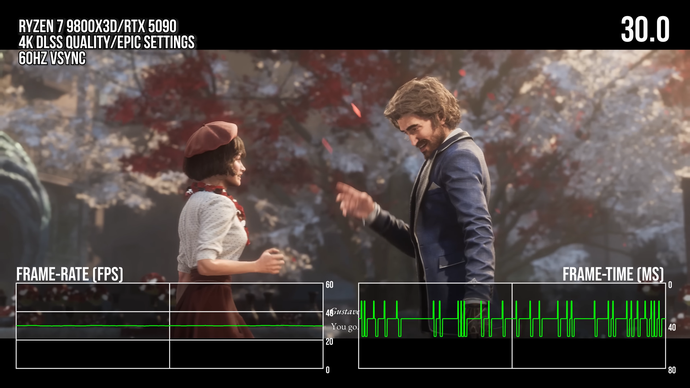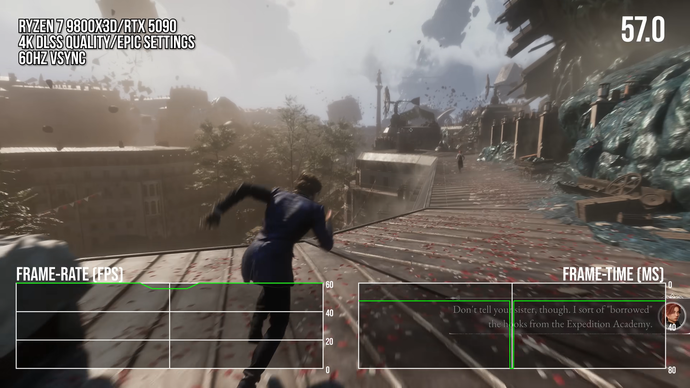Recent indie darling Clair Obscur: Expedition 33 is more polished on PC than you might expect from the size of its core development team, but it still has some presentation issues that conflict with its narrative focus and some PC-specific problems that make the PC release arguably the least polished version of the game.
Clair Obscur is built on Unreal Engine 5, giving access to modern graphical features but also opening the door to some familiar issues. The game’s settings are largely cribbed from the standard UE options, but unfortunately there’s no option to use hardware Lumen ray tracing, so players are stuck with the somewhat-compromised software version of Lumen global illumination and reflections. Otherwise, we generally recommend sticking to the settings that developers Sandfall Interactive have selected for the console version of the game, which we’ll cover later.
Before that, let’s quickly run through the game’s presentation issues, which all seem fixable. The first is how cutscenes are presented, with a (poorly frame-paced) 30fps limit that means the game necessarily underperforms on higher-end and future hardware that could easily run these scenes at 60fps or higher. It’s distracting to see the game swap from 60fps or even 120fps back to this unstable 30fps limit, and it ought to be possible for players to disable the cutscene frame-rate cap if they prefer – without resorting to third-party mods like Lyall’s ClairObscurFix. The same frame pacing issue, with frame-times varying from 16.6ms to 50ms rather than coming at a constant 33.3ms, also applies to pre-rendered cutscenes, making them look jerky.
Beyond cutscenes, the gameplay itself also has smoothness issues from a variety of sources that I want to highlight so that they can be fixed. These aren’t quite as bad as the recent Oblivion remaster, for example, but the game still suffers from its fair share of frame-time hiccups and stutters – two of which are unique to the PC version.
As you might have already guessed, Clair Obscur features shader compilation stutter throughout the experience. There’s no indication in the UI that a shader compilation step is ocurring, but this seems to happen invisibly during chapter loads. Unfortunately, the capture process seems to have missed many effects, causing frame-time spikes in the 80 to 150ms region when running through an area for the first time. These stutters then don’t re-occur until you update your game or graphics card drivers, proving they are due to shader compilation. Therefore, better shader pre-caching is required.
The other PC-specific stutter is microstutter that affects the game’s camera movement. Unless your frame-rate perfectly matches the in-game frame-rate limiter value – eg you are running with the frame-rate unlocked – the camera noticeably hitches when turning and spinning. Fixing this requires you to set a frame-rate limit and then hit that limit throughout, eg having hardware capable of remaining at 60fps throughout the game while having a 60fps limit set – though sometimes the frame-rate limit can change to 59fps and you’ll see the same issue. In short, Sandfall need to ensure camera motion is not tied to an arbitrary frame-rate to fix the issue.
Beyond these two sources of PC-specific stutter, the PC version also suffers from the traversal stutter that afflicts the console versions. In short, crossing invisible boundaries in the game world causes a frame-time spike when running with an unlocked frame-rate. For example, I saw a 40ms hitch when running on a low-end Ryzen 5 3600, which repeats each time the boundary is crossed – unlike the shader compilation stutter that only occur once in a session. Interestingly, faster CPUs don’t reduce the size of these hitches, with a bleeding-edge Ryzen 7 9800X3D showing nearly identical pauses. The best way to hide these hitches is by utilising third-party frame-rate caps (like those from Special K) or using v-sync at 60Hz. This prevents the 40ms traversal stutter on the 9800X3D, but doesn’t do so on the slower 3600.
I don’t expect the developers to fix the game’s traversal hitching or animation hitching issues, as they are endemic to nearly all Unreal Engine games on all platforms, but it would be great if they looked at fixing the shader compilation hitches and camera microstuttering – which seem like oversights that could be more easily corrected.
Similarly, it would be good if the developers allow players to weaken or disable the intense sharpening filter used on the PC version of the game (without the ClairObscurFix mod), which gives the whole game a crunchy look with lots of aliasing. This doesn’t appear to be present on the console version and should be possible to disable without mods. Finally, DLAA looks broken here, which looks blurrier and overall worse than DLSS, regardless of display driver.


Getting into optimised settings, I think the PS5 Pro‘s performance mode is a good place to get optimisation ideas. For example, PS5 Pro appears to use the medium setting here, which turns off variable penumbra but keeps the shadows fairly high resolution. Medium saves 19 percent in terms of performance versus the epic preset, though high is also a reasonable 13 percent savings that could be a good fit for higher-end GPUs.
The next more obvious visual difference on PS5 Pro is in the foliage quality, which appears closest to the PC’s high setting and results in a three percent performance win for little visual difference. The medium and low settings, by constrast, result in dramatically worse visuals with little commensurate frame-rate improvement. Reflections are another good way to save a bit of performance, with the PS5 Pro setting of medium.
The last setting to watch out for explicitly is the Global Illumination setting, for which I recommend the high setting as it provides a good performance win without a noticeable hit to fidelity. The worst aspects of the high setting versus epic is that high reduces shading quality on hair in areas of indirect lighting. The epic setting may be bugged here, as a number of scenes have objects that look like they’re floating and are strangely occluded, so high makes more sense at present even on higher-end GPUs. Other settings are generally set to high, as we normally see this preset offers the best blend of performance and visuals.
| PS5 Pro (Performance) | PC Optimised | |
|---|---|---|
| Anti-aliasing | ? | DLSS, XESS, FSR |
| Shadows | Medium | Medium |
| Global illumination | Unique to consoles | High |
| Reflection | Medium | Medium |
| Post process | ? | High |
| Texture | Epic | Epic |
| Visual effects | ? | High |
| Foliage | High | High |
| Shading | ? | High |
Using these optimised settings instead of epic across the board, performance rises by 57 percent in an outdoor scene on the RTX 4060 at 1440p. Dropping down to DLSS in balanced mode results in more than triple the frame-rate versus using epic settings at native resolution, so there is a decent amount of scaling here with relatively few settings changes.
It’s also possible to force DLSS 4’s better tranformer model for DLSS in the Nvidia driver, which let me play on the Ryzen 5 3600 plus RTX 4060 PC at DLSS balanced mode with good results. This even allowed the epic texture setting to be used, with no calamitous frame-rate drops as we sometimes see with graphics cards at their VRAM limit. Instead, UE5’s virtual texturing meant that some textures loaded slowly on a camera cut, but in gameplay textures were fine. Image quality, especially on fine elements like hair, was the only noticeable sticking point graphically, and the game otherwise ran in the 50s during heavy combat and at 60fps or higher the remainder of the time. In general then, the game does scale down well enough to provide a good experience on a lower-end 8GB GPU.
Overall, I had a lot of fun with Clair Obscur: Expedition 33 and found it extremely engaging, despite the issues I mentioned above. This game is surprisingly well-polished for an Unreal Engine 5 release. With a few meaningful changes – like the ability for players to unlock cutscene frame-rates and remove the sharpening filter, and fixes for the shader compilation and camera microstutter issues – this could be a technically spectacular game on PC. Given how successful the game has proven, I hope that the necessary time and attention can be given for the developers to sort out these lingering issues and see the game hit its full technical potential.
